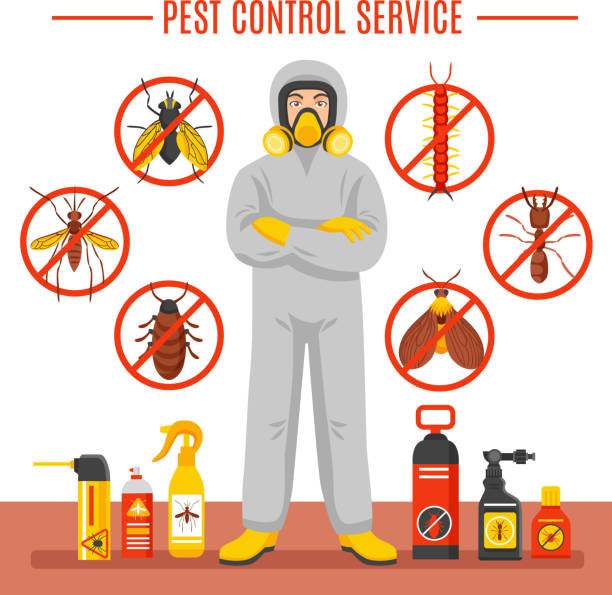Pest Control featuring safe and child-friendly solutions.
Pest Control featuring safe and child-friendly solutions.
Blog Article
Eco-Friendly Bug Control Approaches for Handling Wildlife in Urban Areas
Urban locations frequently discover themselves at the junction of human activity and wild animals, leading to special difficulties in pest management. These approaches not only shield the atmosphere but likewise improve area engagement in wild animals administration. As city populations proceed to expand, comprehending the characteristics of wildlife interactions ends up being significantly important.
Understanding Urban Wildlife Dynamics
Understanding Urban Wild animals Characteristics is important for developing effective and eco-friendly parasite control methods. Urban areas are significantly ending up being environments for different wildlife varieties, driven by variables such as habitat fragmentation, food schedule, and human encroachment. Recognizing these characteristics enables for a nuanced technique to pest administration that aligns with eco-friendly concepts.
Urban wild animals commonly consists of species such as raccoons, squirrels, and birds, which adjust to city settings, discovering specific niches in environment-friendly rooms, parks, and also residential locations. Their visibility can bring about problems with people, specifically when they manipulate personnels for food and sanctuary. Understanding the habits and ecological roles of these varieties notifies methods that decrease adverse communications while advertising biodiversity.
Additionally, recognizing the interdependencies within city environments aids in recognizing critical locations for environment preservation and reconstruction. This knowledge adds to the development of incorporated insect management (IPM) methods that consider the environmental equilibrium, thereby reducing reliance on hazardous chemicals. By promoting conjunction in between people and city wildlife, cities can create healthier settings that profit both residents and neighborhood ecosystems, leading the way for lasting urban living.
Natural Repellents and Deterrents
All-natural repellents and deterrents provide a lasting alternative to standard insect control approaches by utilizing the power of nature to maintain undesirable species away. These green options usually make use of plant-based components, vital oils, and other normally happening materials that hinder pests without hurting the setting.
One efficient all-natural repellent is peppermint oil, which is understood to drive away rats and bugs. Its solid aroma is undesirable to several pests, making it a popular selection for city settings. Likewise, vinegar and citrus peels can serve as deterrents, as their solid odors are normally unattractive to various wild animals.
Additionally, diatomaceous earth is a natural powder that can be spread out in areas susceptible to insect task, efficiently dehydrating and hindering pests without posturing dangers to non-target species. Furthermore, garlic sprays and neem oil are identified for their capacity to fend off a large array of bugs, consisting of both insects and bigger wild animals.
Executing these all-natural repellents not just lowers reliance on chemical pesticides however likewise advertises a much healthier metropolitan community, promoting a more well balanced conjunction between people and wildlife. By making use of these strategies, city areas can efficiently take care of parasite populaces while lessening environmental impact.
Habitat Modification Techniques
Efficient environment adjustment methods play a crucial function in sustainable parasite monitoring by changing the environment to make it much less for pest infestations. By comprehending the eco-friendly characteristics of city locations, residential or commercial property owners can apply calculated alterations that discourage parasites while promoting biodiversity.
(Integrated pest management Port Charlotte)One primary method entails keeping proper cleanliness. This consists of normal waste removal, protecting trash containers, and removing standing water to lower breeding websites for pests and rodents. In addition, landscaping practices such as choosing native plants can boost environmental equilibrium, supplying habitats for useful organisms while minimizing resources for pests.
One more essential strategy is to secure entrance points in structures. Evaluating and fixing splits in structures, wall surfaces, and home windows can significantly minimize bug gain access to. Additionally, developing physical barriers, such as fences or plant buffers, can hinder wild animals motion into human-inhabited locations.
Integrated Pest Management Practices
Structure upon habitat modification strategies, incorporated bug administration (IPM) techniques supply an all natural method to managing pest populaces while reducing environmental impact. IPM integrates numerous techniques, including biological, social, mechanical, and chemical controls, to achieve efficient pest monitoring.
Biological control entails the introduction of all-natural predators or bloodsuckers to minimize pest populaces. Cultural methods, such as crop rotation and sanitation, interfere with pest life cycles and lessen their habitats - Pest control service. Mechanical controls, like traps and obstacles, provide prompt remedy for pest stress without chemical treatment
Chemical controls are used as a last hope, concentrating on Pest inspection Port Charlotte targeted applications that restrict harm to non-target varieties and the environment. The choice of environmentally pleasant chemicals, when needed, is important to the IPM structure. In addition, monitoring bug populaces and analyzing potential damage aids educate decision-making, making certain that treatments are timely and reliable.
Area Involvement and Education

(Stable Fly Control)Workshops and informative sessions can gear up locals with knowledge concerning indigenous species, environment conservation, and effective safe insect management methods. Cooperation with colleges, neighborhood organizations, and government agencies further boosts instructional outreach, guaranteeing that necessary details reaches varied target markets.
Furthermore, community-led efforts, such as community clean-up days and environment remediation jobs, not just promote biodiversity yet also strengthen area ties. Pest control service. By motivating citizens to share their experiences and monitorings, communities can establish targeted techniques that resolve certain regional pest concerns
Incorporating responses from residents into insect monitoring prepares allows an extra responsive and adaptive technique to wildlife obstacles. Eventually, notified and engaged neighborhoods are key to accomplishing long-lasting success in environmentally friendly insect control, resulting in healthier city settings that value both human and eco-friendly needs.

Final Thought
In final thought, environmentally friendly bug control comes close to deal lasting solutions for handling urban wild animals. By prioritizing habitat adjustment, using natural repellents, and carrying out integrated insect administration methods, neighborhoods can promote a harmonious coexistence with regional animals.
Report this page